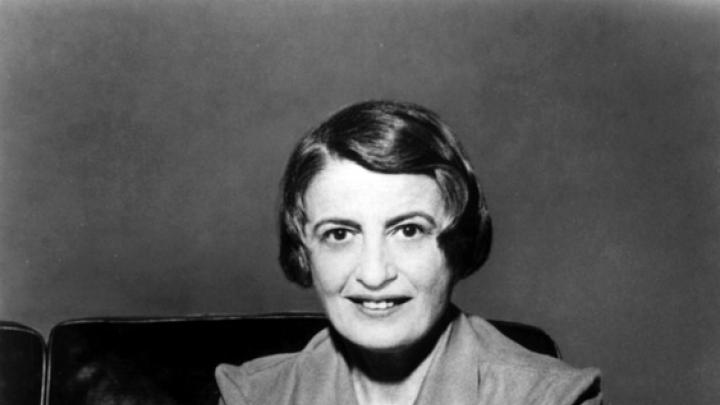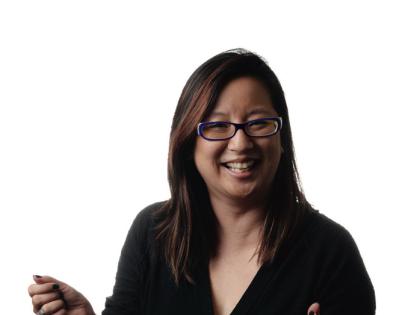Ayn Rand was finally getting her due. After Time magazine had called her masterpiece—the novel Atlas Shrugged—“a nightmare,” after the eminent philosopher Sidney Hook had savaged her in the New York Times Book Review, she had been invited to Harvard to present a paper on her philosophy of art. Her host, John Hospers, a rising young philosopher from Brooklyn College, belonged to the American Society for Aesthetics, which was meeting in Cambridge in October 1962.
Rand’s appearance at Harvard marked a pinnacle in her already astonishing career. Born Alisa Rosenbaum in St. Petersburg, the eldest daughter of affluent Jewish parents, she fled Russia in 1926, embittered by the Bolshevik Revolution, which had destroyed her family’s livelihood. Upon arrival in New York, she assumed the more glamorous nom de plume Ayn Rand and headed for Hollywood.
Rand’s new name was the first of her many reinventions. She began as a hack Hollywood writer but then wrote two plays and a novel. Soon she was a political activist, too, working to defeat Franklin Roosevelt’s New Deal, which she feared was only the first step toward communism in America. Her second novel, The Fountainhead, published in 1943, was treasured by a small band of conservatives who applauded her attack upon collectivism and her bold defense of selfishness. It was also a bestseller that vaulted Rand to literary fame, and would become a successful film six years later.
But already her ambitions were changing. Rand’s early writing reflected her belief in individualism and commitment to free-market capitalism, developed during her years under Soviet rule. By 1957, when she published her third novel, Atlas Shrugged, she had codified and extended her ideas into a system she called Objectivism, which elevated selfishness to a virtue. Rand now understood herself as a philosopher as much as a novelist. In 1961 she published her first work of nonfiction, For the New Intellectual, and one of her young acolytes, Nathaniel Branden, began offering courses in Objectivist philosophy in New York.
The problem was that few of Rand’s contemporaries accorded her philosophy any respect. Atlas Shrugged was panned by critics and hated by academics, who detested both her politics and her romantic writing style. Some professors automatically failed any student who wrote about Rand; others published articles warning of her terrible influence on youth. Hospers was one of the few scholars genuinely interested in her ideas, and his allegiance was priceless.
As much as she preached a philosophy of unfettered individualism and independence, Rand craved the respect and esteem of her fellow intellectuals. It was intellectuals, after all, who shaped history: in a political fundraising letter, she asserted that “only a handful of eighteen men” had transformed the country of her birth from a proud center of European civilization to a wasted land of starvation, stagnation, and murderous labor camps.
Her Harvard talk, then, offered Rand a rare opportunity to establish herself as a philosopher before a receptive academic audience. She spoke on “Art as Sense of Life,” one of her minor, if favored, themes. “Sense of life” in the Randian corpus refers to the sum total of an artist’s assumptions, experiences, and judgments about life: his or her evaluation of the universe. Sense of life was critical to art, Rand argued, because art was a metaphysical estimate of humanity’s existence. By all accounts, Rand was an excellent teacher; despite her thick Russian accent, there is little doubt she presented her thesis clearly and logically. Still, some of her preferences were apt to surprise. In her writing, for example, she savaged Thomas Wolfe, whose sprawling semibiographical epics suggested an undisciplined mind and a universe that was dark, sordid, and capricious. She preferred the pulpy crime novels of Mickey Spillane, who depicted a black-and-white universe where good defeated evil.
What happened next is a matter of some dispute. As the designated commentator, Hospers rose and delivered some remarks on Rand’s presentation. At least one of her entourage remembered his words as surprisingly sarcastic and harsh. Hospers himself thought his comments, while critical, were entirely typical. “I could not simply say how great her remarks were and then sit down,” he recalled.
But there was no mistaking Rand’s reaction. She lashed out at him immediately from the dais, raising eyebrows in the crowd. At a party afterwards, she refused to speak to him. He had criticized her before the very audience she hoped to win over; the sin was unforgivable, and the breach would never heal. It was a significant turning point for Rand, who gave up on professors altogether and devoted herself instead to her growing band of supporters.
As it turned out, Hospers would not long be alone in his admiration for Rand’s ideas. In 1972, he was chosen the first presidential candidate of the Libertarian Party, which considered Rand a primary influence. Libertarians took her ideas to Washington, D.C., making her a touchstone of the emerging conservative movement. (Her most famous follower, Alan Greenspan, became chairman of the Federal Reserve.) Nowadays Atlas Shrugged sells more than 200,000 copies each year, and professors are more likely to assign than attack Rand’s writing. Nearly 30 years after her death, Rand’s once controversial philosophy of individualism and capitalism has become part of the warp and woof of American political culture.








